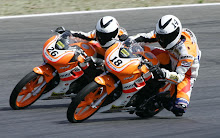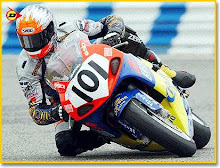First launched in 1992, Honda CBR900RR featured a large displacement engine fitted on a relatively lightweight and nimble frame. But the series of changes had long started as Tadao Baba initially designed the Fireblade as a 750cc engine back in 1989.
The name Fireblade saw its way through in the bike’s early years of development by a mis-translation from French to English for the Japanese word for lightning. It became the internal adopted name for the project’s development although all Honda inline-engined sport motorcycles of the time were labeled CBR, followed by a number approximately equal to the engine’s capacity in CC. However, Baba-san had said that as the project came to launch, the internal name was chosen as the bike’s marketing name so as not to emphasize the first Fireblade’s 893cc engine displacement, because at the time potential customers not accustomed to the new concept of lighter and agile superbikes would not perceive a motorbike of less than 1000cc as a competitor for the Yamaha FZR1000T or Suzuki GSXR1100N.
Developing 124 horsepower and moving 454.2 lb with its inline four-cylinder engine, the first Fireblade was indeed a competitor for the Suzuki and Yamaha as it used a simple but yet successful recipe: big displacement motor positioned on a bike as light as a 600cc, if not lighter.
This made for the bike to sell quickly demanding soon out stripped supply, as riders could not believe just how fast, light weight, a class breaking 185kg and easy to ride this new bike was, especially in the hands of rider’s more used to heavy weight bikes of the time like the Kawasaki ZX10, Suzuki GSX-R1100 and even Honda’s own CBR1000F.
Initially, due to the 16-inch front wheel making the front seem twitchy, there were some calls for a steering damper but the choice of wheel was soon proved to be the correct as the reduced unsprung weight of the 16-inch over a 17-inch improved the bike’s turning ability.
The colors for the first model year were red/white/blue but there was also the black and silver version so riders could easily make their minds and decide on a color scheme.
Future years brought visual upgrades for the already successful product so the bike received a new fairing in the shape of the redesigned bodywork, as the now familiar Foxey/Urban Tiger came along in December 1993.
Honda had prepared a big revamp for the Fireblade at the end of 1995 and it was now known as the CBR918RR. The name gives a very clear clue of the increase in displacement but this was unusual for Honda, to feature an all new dedicated 918cc engine, not the previous Japan-only bored-out 750 cc engine. Other updates aimed at improving the riding position but, very important, 1995 brought the upgrade of the suspensions. That model year was introduced as the RRT model.
Keeping their recipe for 1997, when the RRV model was released, Honda had added some horses and reduced the weight a little bit by using a new aluminum silencer. Weighing only 183 kg, the only thing that the bike than needed were some new color schemes which gave a new apparel and made that model year stand out even more.
1998 brought the RRW/X models featuring a redesigned fairing and headlamp unit and a wider seat/tail light unit. The upgrade now needed to bring better handling, was only achieved with a much stronger fork yoke unit and stiffness provided by a redesigned swingarm. That model year also brought the adding of a 17-inch front wheel instead of the previous 16-inch. The new element, taken right out the CBR600 completely transformed the handling and together with the new suspension parts made the critics raise no handling issues.
The new millennium had a great influence on the Fireblade, by then known through its all new fuel injected 929cc engine, upside down forks and a much awaited 17 inch front wheel. Baba-san had also given the bike a squarer look, with a dry weight of 170kg, losing 9kg in the process.
After losing out the Yamaha R1 in the sales charts, Honda understood that they have to increase displacement even more so the CBR929RR lasted for only two years.
Replacement came in 2002 and it was called Honda CBR954RR. The bigger capacity engine had the effect of producing 149 bhp and 77 ft lbf of torque with the help of a heavily improved EFI system with bigger injectors and more processing ability. It also handled better due to frame and headstock strengthening, and a more rigid swingarm. Weighing in at a class leading 169 kg it also weighed less than Honda’s own CBR600RR. Everything was dressed up beautifully in an altogether much leaner, sleeker, tougher look and after two years of production the CBR954RR saw its way out as it had completed its goal in Honda’s big class superbike history.
After the Fireblade exited the scene, the all-new 2004 CBR1000RR arrived at a true liter of displacement to line up with the other bikes built by the rest of the Japanese manufacturers. The team that built the fabulous Honda RC211V race bike from the MotoGP series was also behind the development of the CBR600RR and it was logical to take care of the development in the big superbike class at Hondas, which they did. It resulted in new technologies being implemented such as a lengthy swingarm, Unit Pro-Link rear suspension, and Dual Stage Fuel Injection System (DSFI).
Almost no part of the CBR954RR were carried over to the development of the new model as the compact 998cc in-line four was a completely new design featuring unique bore and stroke dimensions, race-inspired cassette-type six-speed gearbox, all-new ECU-controlled ram-air system, dual-stage fuel injection, and a center-up exhaust provided with a new computer-controlled butterfly valve. The chassis was likewise all new, including an organic-style aluminum frame composed of Gravity Die-Cast main sections and Fine Die-Cast steering head structure, inverted fork, Unit Pro-Link rear suspension, radial-mounted front brakes, and a centrally-located fuel tank hidden under a faux cover.
What made the new CBR1000RR behave so well under strong acceleration was the longer swingarm, acting as a longer lever arm in the rear suspension system. This element also determined the increase of wheelbase with 34mm.
But making room for the new swingarm required massive changes to the engine architecture, completely changed from the 954’s. Shortening the engine compared to the 954 meant rejecting the conventional in-line layout. Instead, engineers positioned the CBR1000R’s crankshaft, main shaft and countershaft in a triangulated configuration, with the countershaft located below the main shaft, dramatically shortening the engine front to back, and moving the swingarm pivot closer to the crankshaft. Honda had learned the lesson from Yamaha who implemented the design on the 1998 YZF-R1.
The engine was positioned farther forward in the chassis in order to keep its great amounts of power and torque to wheelie prone when not desired. This also provided very little space between the front wheel and the engine but the problem was solved by giving the RR a modest cylinder incline of 28 degrees, and moving the oil filter from its frontal placement on the 954 to the right side of the 1000RR engine. This allowed the RR’s center-up exhaust system to tuck closely to the engine, opening the space required for a massive MotoGP-style curved radiator with 40 percent more cooling capacity than the 954’s unit, a key to making big horsepower with high durability.
By concentrating the component masses as close to the motorcycle’s center as possible, Honda uses the engine designed especially toward horsepower and torque and makes the bike handle like a dream. The idea of mass centralization had never been better used than on the 2004 Honda CBR1000RR featuring an engine employing a relatively modest 75mm bore and 56.5mm stroke to derive the displacement of 998cc. The choice proved to be very benefic because the remarkable narrow engine attached on a commensurately narrow chassis increases mass centralization and ground clearance also.
The starter motor and drive gear were positioned on the right side of the engine providing a narrower engine profile for added ground clearance. The balancer shaft on the CBR1000RR did its job of eliminating secondary vibration properly but also had an eye towards mass centralization, also being positioned close to the engine’s center of gravity.
Another design providing a wealth of benefits was the Unit Pro-Link’s. The shock is contained entirely within the swingarm and is positioned lower than in a conventional design. Both contribute to mass centralization, in part by giving the centrally mounted fuel tank room to extend downward. Because the shock is contained within the swingarm and it doesn’t require a top mount on the frame, the bulk of the 4.8-gallon tank was positioned down low between the frame rails, close to the centerline of the machine. Two other benefits resulted from the RR’s fuel placement; the mass of the fuel load has less effect on handling, thereby facilitating quick directional changes; and, because the fuel tank is shorter, the CBR1000RR rider sits closer to the steering head than on the 954.
Quicker handling was achieved by lightening as many pieces far from the center of mass as possible. That gave rise to the RR’s compact Line-Beam headlights, with their high-illumination three-piece reflectors; slim-line LED taillight; single-piston rear brake system that’s lighter that of the 954; an analog/digital fully electronic instrument that’s one of the lightest and slimmest ever mounted on a street bike, among more other changes.
Being a brand new product, derived from a motorcycle filled with heritage coming from a motorcycle named after a mis-translation from French to English of the Japanese word for lightning, the CBR1000RR enjoyed its complete revision which determined designers to maintain the bike’s characteristics for 2005.
But that was no brake period as they prepared the next evolutionary step of the CBR1000RR for 2006. This aimed at improving the engine performance by adding new intake and exhaust porting, higher compression ratio, revised cam timing, more intake valve lift, double springs for the intake valves, all resulting into a higher redline.
The rear now featured a larger sprocket, revised suspension with new linkage ratios, and a new, lighter swingarm while the front received a revised front fairing design, larger 320mm front brake discs but thinner at 3.5mm, and a revised front suspension.
This model carried over to 2007 remaining mostly unchanged. The brushed aluminum swingarm was now black to complete the new color schemes available: Black, Red/Black, Satin Silver and Race-Replica Repsol.
The Paris International Motorcycle Show on 28 September 2007 brought the presentation of a brand new CBR1000RR for 2008, a motorcycle now presented on this review.










